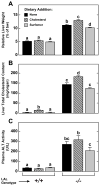Ezetimibe markedly attenuates hepatic cholesterol accumulation and improves liver function in the lysosomal acid lipase-deficient mouse, a model for cholesteryl ester storage disease
- PMID: 24370824
- PMCID: PMC3935496
- DOI: 10.1016/j.bbrc.2013.12.096
Ezetimibe markedly attenuates hepatic cholesterol accumulation and improves liver function in the lysosomal acid lipase-deficient mouse, a model for cholesteryl ester storage disease
Abstract
Lysosomal acid lipase (LAL) plays a critical role in the intracellular handling of lipids by hydrolyzing cholesteryl esters (CE) and triacylglycerols (TAG) contained in newly internalized lipoproteins. In humans, mutations in the LAL gene result in cholesteryl ester storage disease (CESD), or in Wolman disease (WD) when the mutations cause complete loss of LAL activity. A rat model for WD and a mouse model for CESD have been described. In these studies we used LAL-deficient mice to investigate how modulating the amount of intestinally-derived cholesterol reaching the liver might impact its mass, cholesterol content, and function in this model. The main experiment tested if ezetimibe, a potent cholesterol absorption inhibitor, had any effect on CE accumulation in mice lacking LAL. In male Lal(-/-) mice given ezetimibe in their diet (20 mg/day/kg bw) for 4 weeks starting at 21 days of age, both liver mass and hepatic cholesterol concentration (mg/g) were reduced to the extent that whole-liver cholesterol content (mg/organ) in the treated mice (74.3±3.4) was only 56% of that in those not given ezetimibe (133.5±6.7). There was also a marked improvement in plasma alanine aminotransferase (ALT) activity. Thus, minimizing cholesterol absorption has a favorable impact on the liver in CESD.
Keywords: ALT; CE; Cholesterol absorption; Fatty liver; Hepatomegaly; Intrahepatic; LAL; LIPA; NPC1L1; Niemann-Pick C1-Like1; SI; Small intestine; TAG; Triacylglycerol; UC; alanine aminotransferase; cholesteryl ester; gene that encodes LAL; lysosomal acid lipase; small intestine; triacylglycerol; unesterified cholesterol.
Copyright © 2013 Elsevier Inc. All rights reserved.
Figures



References
-
- Liu B, Xie C, Richardson JA, Turley SD, Dietschy JM. Receptor-mediated and bulk-phase endocytosis cause macrophage and cholesterol accumulation in Niemann-Pick C disease. J Lipid Res. 2007;48:1710–1723. - PubMed
-
- Goldstein JL, Dana SE, Faust JR, Beaudet AL, Brown MS. Role of lysosomal acid lipase in the metabolism of plasma low density lipoprotein. Observations in cultured fibroblasts from a patient with cholesteryl ester storage disease. J Biol Chem. 1975;250:8487–8495. - PubMed
-
- Grabowski G, Du H. Lysosomal Acid Lipase Deficiencies: The Wolman Disease/Cholesteryl Ester Storage Disease Spectrum. In: Valle D, Beaudet A, Vogelstein B, Kinzler K, Antonarakis S, Ballabio A, editors. Scriver's Online Metabolic and Molecular Basis of Inherited Metabolic Disease. McGraw-Hill; 2012.
-
- Bernstein DL, Hulkova H, Bialer MG, Desnick RJ. Cholesteryl ester storage disease: review of the findings in 135 reported patients with an underdiagnosed disease. J Hepatol. 2013;58:1230–1243. - PubMed
Publication types
MeSH terms
Substances
Grants and funding
LinkOut - more resources
Full Text Sources
Other Literature Sources
Molecular Biology Databases

